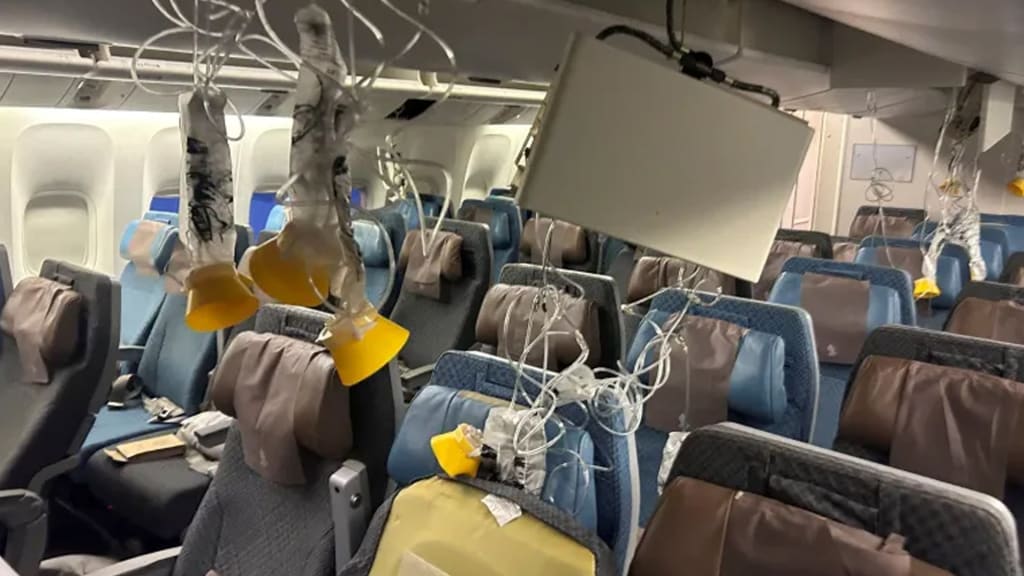Content warning
This story may contain sensitive material or discuss topics that some readers may find distressing. Reader discretion is advised. The views and opinions expressed in this story are those of the author and do not necessarily reflect the official policy or position of Vocal.
What’s air turbulence and how deadly can it be?
What’s air turbulence and how deadly can it be?

Regular travellers are more or less familiar with turbulence during air travel. In most cases, such jolts do not pose much risk to the passengers. However, sometimes these violent shakings can cause injuries and even death.
Recently, a Singapore Airlines flight from London to Singapore suffered deadly air turbulence. Passengers were thrown out of their seats in mid-air due to the strong shaking, during which the luggage also fell from the racks above. In addition to the death of one passenger, at least 104 passengers, including the crew, suffered minor to serious injuries.
Shortly after this incident, a Qatar Airways flight from Doha to Dublin was hit by air turbulence while flying over Turkey, injuring at least 12 people, including six crew members. Although in both cases the planes later landed safely, they show how air turbulence can be dangerous.
What is air turbulence?
Turbulence or pockets of disturbed air can have many causes, most obviously the unstable weather patterns that trigger storms, according to an industry briefing by planemaker Airbus. The resulting water particles can be detected by weather radar.
Singapore Airlines did not immediately say what type of turbulence was involved. Tracking service FlightRadar24 said there were storms—some severe—in the area at the time.
Known by its abbreviation CAT, clear air turbulence is a sudden and severe swirl that causes violent buffeting of a plane even where there are no clouds. Such invisible pockets of air can appear without warning and are hard to predict.
NASA says it is developing an early-warning system that relies on ground-mounted infrasonic microphones to detect clear-air turbulence hundreds of miles away.
Austria-based tech startup Turbulence Solutions says it is developing technologies to eliminate up to 80% of turbulence, according to Reuters.
But industry experts caution that any new aircraft systems must be proven to work to a high level of reliability, and it takes years of rigorous testing before technology can be validated. Airlines must usually agree to foot the bill for any upgrades.
CAT hit Singapore Airlines flight?
Director (Flight Operations) of Fly Dhaka Airlines, Captain Abdullah, a pilot with 40 years of flying experience, told Somoy that air turbulence is generally divided into four categories: light, moderate, severe and extreme.
The Singapore Airlines flight was hit by an extreme turbulence or CAT.
Captain Abdullah said that this type of air flow occurs even in a cloudless clear sky mainly because of the jet stream or the difference in air temperature and humidity.
There are differences between the air above and the air below the jet stream. He said the Singapore Airlines flight was mainly hit by turbulence when it passed through the clear air turbulence zone caused by such a jet stream. As the plane entered the zone, the air above pushed it down, forcing the plane down by 6,000 feet in just two to three minutes. The situation was extremely dangerous.
How deadly is CAT?
Citing the fear for pilots of being exposed to such clear air turbulence, Captain Abdullah said weather radar usually provides information to pilots about the weather conditions en route to their destination. In this case, pilots avoid the route with bad weather and fly through the surrounding area. But radar usually does not detect clear air turbulence. Because of this, pilots often fall into this zone accidentally and unprepared.
However, in most cases, experienced pilots can predict the area of clear air turbulence, said Abdullah.
He said that before leaving for the destinations, pilots are briefed about the weather pattern of the route. Pilots generally exercise caution when flying based on the information obtained in these briefings. They may use caution when flying in areas where the briefing mentions jet streams because clear air turbulence occurs more in the area of the jet stream.
Also, the aircraft's weather radar provides the latest information about the wind flow. If pilots keep a close eye on this weather radar, they can easily get a glimpse of the fluctuations in air flow. If they notice that the speed and flow of these air currents frequently change, or fluctuate, over a particular area of the sky, they can ask pilots of other aircraft that have passed through that area some time ago about their experiences. And according to the information given by them, one can avoid that place by slightly adjusting the altitude, speed and route.
The pilot's caution and experience can be useful in avoiding air turbulence,” he said. Referring to the Singapore Airlines flight, he said, there might not have been so much damage if the pilot had taken precautions and brought the plane down by several thousand feet and reduced its speed.
How Captain Abdullah tackled air turbulence?
Talking about the experience of facing air turbulence, Abdullah recalled that around 2004, he was a victim of the "severe" category of air turbulence over Turkey on the way from Dhaka to Rome. When the flight entered Turkish airspace at a height of 36,000 feet, he suddenly started to feel shaking in the plane.
He quickly reduced speed and brought the plane down by 2,000 feet but the shaking continued. He slowed down the plane further and brought it down to 30,000. In this way, he managed to pass through the area without suffering any damage.
Modern aircraft can survive severe turbulence
Passengers are always apprehensive of air turbulence. Many people are afraid of plane crashes. However, in cases of the most serious turbulence, there is hardly any danger of the plane crashing, experts say. Manufacturers design the aircraft in such a way that they can survive such extreme air turbulence.
Regarding the structure of modern passenger aircraft to withstand the shock stress of air turbulence, Captain Abdullah said that aircraft manufacturers design their aircraft considering the most severe air turbulence risks.
Referring to the turbulence-affected plane of Singapore Airlines, he said that due to the shaking, there was a lot of damage inside the plane, but it was not known that there was any damage to the structure of the plane. It landed safely in Thailand.
Air turbulence over Bangladesh’s sky?
Captain Abdullah said that the small planes like ATR or Dash-8 operating on domestic routes do not suffer from clear air turbulence like the plane of Singapore Airlines. He said that extreme or severe clear air turbulence events usually occur at least 30,000 feet above the ground. That's where the jet stream usually flows. And the ATR or Dash-8 planes don't fly that high in the sky; they usually fly between 12,000 and 15,000 feet.
However, about the risk of air turbulence on the international routes that Bangladeshis travel, Captain Abdullah said that there is a risk of air turbulence on the routes from Dhaka to Guangzhou and Japan. Besides, there is a risk of encountering air turbulence over the skies of Afghanistan and Turkey on the way from Dhaka to Europe. The direction and velocity of the wind change rapidly because these regions are mountainous.
However, there is not much risk of encountering air turbulence on the way from Dhaka to Dubai or other routes in the Middle East. Besides, Captain Abdullah said that there is hardly any instance of major turbulence in the history of Biman Bangladesh Airline.
Areas with frequent air turbulence
enerally, random patterns are observed in the air flow in the sky of high mountains or oceanic regions. Also, around the equator and in regions where the "jet stream" flows through the atmosphere, aircraft are most exposed to air turbulence.
Air turbulence is common in the Alps of Europe, the Andes of South America, the Hindu Kush and the Himalayas near the border of Pakistan and Afghanistan, Central Asia and the mountainous regions of Turkey. Apart from this, due to the jet stream air flow occurring in the atmosphere of North America and northern China and Japan, the planes on this route often experience more or less turbulence.
In addition, experts believe that there is a risk of air turbulence in the Bay of Bengal region during the monsoon.
Based on data from the United States' National Oceanic and Atmospheric Administration and Britain's Met Office, Turbuli, a Sweden-based website that provides air turbulence forecasts, has published a list of some of the routes with the most air turbulence. According to the list, in 2023, flights from Santiago in Chile to Santa Cruz in Bolivia, Almaty in Kazakhstan to Bishkek in Kyrgyzstan, Lanzhou to Chengdu in China, Sentair to Sendai in Japan, Milan in Italy to Geneva and Zurich in Switzerland were the most bumpy routes.
How to stay safe during turbulence?
Airplanes are designed to withstand rough conditions and it is rare for aircraft to incur structural damage because of turbulence.
But turbulence can toss passengers and crew members around, potentially causing grave injuries like bone fractures and hemorrhages. Experts emphasise staying seated and keeping seatbelt on as much as possible during flights are the best ways to reduce risks.
Fatalities caused by turbulence, while exceedingly uncommon, do happen. The last time a passenger on a commercial flight operated by an American airline died from a turbulence-related injury was in 1997, when a United Airlines flight from Tokyo to Honolulu experienced severe turbulence over the Pacific Ocean, according to an NTSB investigation. This passenger was not wearing a seatbelt and flew up from her seat, possibly striking her head on the luggage bin, according to the investigation, according to New York Times.
What about babies on laps?
Children younger than 2 years old are allowed to be carried on an adult’s lap during flights, but many industry experts, citing dangers such as turbulence, believe this practice should be prohibited.
For decades, the Association of Flight Attendants-CWA, a union representing about 50,000 flight attendants across 19 airlines, has argued that every passenger have their own seat, no matter their age.
Unexpected turbulence is the leading cause of paediatric injuries on airplanes, according to the FAA, which has detailed information about various child restraint systems and how to correctly install them onto airplane seats. Some of these products are compatible for both cars and airplanes.
#Singapore Airlines flight #Air turbulence
Thanks 👍 All
About the Creator
Angel Malaika
hi i am angel malaika🤞 i love to write especially about technology i love to write in class i am 18 yrs old i have failed in school everyone please pray for me and subscribe my account and my posts friends Thank you all for sharing ❤️❣️
Enjoyed the story? Support the Creator.
Subscribe for free to receive all their stories in your feed. You could also pledge your support or give them a one-off tip, letting them know you appreciate their work.






Comments (1)
Angel Malaika, you are the best!